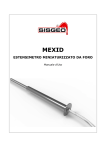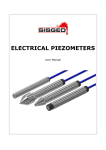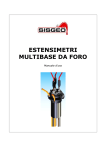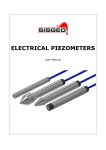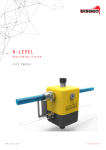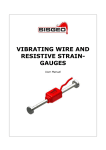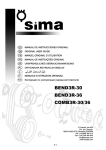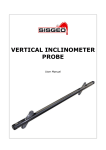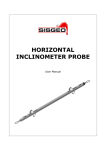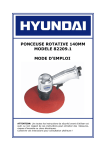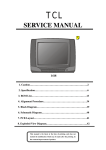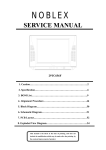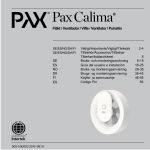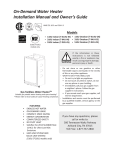Download Manual - SISGEO North America
Transcript
MULTIPOINT ROD EXTENSOMETER User Manual Multipoint rod extensometer INDICE Introduction Pag. 4 Description Pag. 4 Preliminary checks Pag. 7 Installation Pag. 8 Taking measurements Pag. 22 Data processing Pag. 23 Troubleshooting Pag. 24 Maintenance Pag. 24 Appendix 1 Pag. 25 Information contained herein are property of SISGEO S.r.l. This document is subject to change without notification and is subject to be returned upon request. No part of this User’s Manual may be reproduced in any form without SISGEO’s S.r.l. written permission. SISGEO S.r.l. Multipoint rod extensometer_EN_00_12 Page 2 of 25 Multipoint rod extensometer Notes on the use of product For a safe and efficient use of the product, please read carefully the following instructions before starting any operation. Any use of the product other than the one described in this manual shall be considered at user’s full responsibility. The same applies for any unauthorized modifications. In addition to the hereby listed standards, the user must comply with the provisions of the current legislation on the matter of personal safety and health of persons in the workplace. SISGEO is not responsible for any trouble, breakdowns, accidents etc.. due to the lack of knowledge and/or confidence (or non-compliance with) with the requirements contained in this manual. Check that the product has not been damaged during the transport. Verify that the package includes all items as well as any requested optional accessories; if anything is missing, please promptly contact the manufacturer. The user must strictly follow all the operations described in this manual. Maintenance or repair of the device is allowed only to authorized operators. These operators must be physically and intellectually suitable. For information about instrument or order spare parts request, please always specify data written on the identification label. When replacing parts, always use ORIGINAL SPARE PARTS. The manufacturer reserves the right to make changes without prior notice for any technical or commercial requests. We’ll try anyway to keep the manuals updated in order to reflect product’s revisions/updates. Symbols Below are the symbols used to catch reader’s attention on the manual: Pay particular attention to the following instruction. Identification SISGEO S.r.l. Instruments can be identified • From a production lot number (written on the Compliance Certificate) • From a serial number (s/n) engraved indelibly on the instrument • From a label on the instrument • From a label on the cable Multipoint rod extensometer_EN_00_12 Page 3 of 25 Multipoint rod extensometer Introduction Multipoint rod extensometers are used to measure the movements between the head and the anchor points installed at selected depths. They are mostly employed in rocks, but they can also be used in loose soils with appropriate arrangements for the installation. Typical applications are: rock pile strains during tunnel excavation, rock walls straining and buildings settlement. Sisgeo manufactures 2 models: • • Description Single-reading multipoint rod extensometer (mechanical or electric) Double-reading multipoint rod extensometer (contemporary mechanical and electric measure) Multipoint rod extensometer consists in: 1. 2. A head where the rods are fixed. One or more measuring rods. Available in fiberglass, steel or invar. They are protected from grouting through a protection sleeve. Bottom anchors. One for each measuring rod, to be grouted in the ground. 2 grouting tubes. Multicore cable (optional) for connection to a readout. 3. 4. 5. 5 3 2 Protection cover 1 Double-reading multipoint rod extensometer 4 2 3 Protection cover Single-reading multipoint rod extensometer SISGEO S.r.l. Multipoint rod extensometer_EN_00_12 Page 4 of 25 Multipoint rod extensometer Single-reading measuring rods length agreement Middle rod Shortest rod Short grouting tube Long grouting tube Longest rod Double-reading measuring rods lenght agreement Longest rod Long grouting tube Short grouting tube Shortest rod General notes Sisgeo supplies fiberglass multipoint rod extensometers rolled up and ready for the installation, set up with the requested rod number and length. In both steel and invar multipoint rod extensometers, the head with the grouting tubes and the protection sleeve are pre-assembled. Rods, bottom quick joint, terminal tubes and terminal joints have to be assembled on site. In double-reading fiberglass multipoint rod extensometers, the transducers are set up to 50% full scale, unless otherwise requested in the order. SISGEO S.r.l. Multipoint rod extensometer_EN_00_12 Page 5 of 25 Multipoint rod extensometer Measuring methods Measures are carried out through an electric transducer (electric measure) and/or with a digital caliper (mechanical measure). The electric transducer consists in: 1. 2. 3. 4. 5. Transducer body Measuring rod Block pin Cable for readout connection Adjustable joint for the head-fixing. 4 1 5 3 2 Electric transducers, DTE, can be potentiometer with current loop signal 4-20mA (LP) or vibrating wire (VW) and are supplied: • Dismantled, if requested, in single-reading multipoint rod extensometers; • Assembled, in double-reading multipoint rod extensometers. The digital caliper is supplied with extensions, to be used in case of need. SISGEO S.r.l. Multipoint rod extensometer_EN_00_12 Page 6 of 25 Multipoint rod extensometer Preliminary checks Extensometers shall be installed in boreholes with stabilized walls. Boreholes must have a minimum diameter of: • • 45 mm for single point extensometers; 101mm for multipoint extensometers. In the upper 50 cm, the hole must be enlarged up to Ø140mm in order to install extensomer head. We recommend to contact Sisgeo for technical support if the installation would be performed in unstable grounds so that it is necessary to leave the convering in the borehole. Before starting the electric transducers installation, we recommend to perform a control reading with a readout. Useful tools (not supplied): Double-reading multipoint fiberglass rod extensometer Single-reading multipoint fiberglass rod extensometer Double-reading multipoint steel or invar rod extensometer Single-reading multipoint steel or invar rod extensometer Allen key n° 4 Spanner n° 12, 13, 14, 24 2 spanner n° 14 Spanner n° 12, 13, 14, 17, 24 Adhesive tape Tubular box wrench n° 10, 24 Allen key n° 4 Tubular box wrench n° 10, 24 Adhesive tape Pushing rod (assembly kit available in Sisgeo) Pushing rod (assembly kit available in Sisgeo) Jig saw or cutter Jig saw or cutter Adhesive tape 2 pliers Adhesive tape SISGEO S.r.l. Multipoint rod extensometer_EN_00_12 Page 7 of 25 Multipoint rod extensometer Installation VERTICAL INSTALLATIONS DOWNWARD Multipoint fiberglass rod extensometer Unroll the instrument close to the drilling. Assemble the rod centering ring. If necessary, fix, with adhesive tape, the grouting tubes with the rods. Insert the instrument within the borehole Internal nut A B Hold up the head and grout the rod using the longer grouting tube “A”. Grouting tube “B” is for drain and top up. SISGEO S.r.l. Multipoint rod extensometer_EN_00_12 Once the grout hardened, release the rods unscrewing the internal nut first and then the black joint. Now the rod is free to slide in the sleeve. It is possible to assemble the transducers or to take readings with digital caliper. Page 8 of 25 Multipoint rod extensometer Protection cap Install the transducers, or screw the protection cap. SISGEO S.r.l. Multipoint rod extensometer_EN_00_12 Assemble the protection head. cover on the Page 9 of 25 Multipoint rod extensometer Multipoint steel or invar rod extensometer Terminal tube Locate, among the rods, the terminal tubes: they are within a plastic net and have a female thread on one side. Insert the borehole. instrument within the Unroll the instrument close to the drilling. Assemble the rod centering ring. If necessary, fix, with adhesive tape, the grouting tubes with the rods. Hold up the head. Screw a bottom quick joint on a rod SISGEO S.r.l. Multipoint rod extensometer_EN_00_12 Page 10 of 25 Multipoint rod extensometer Insert, in the hole, the rod with the quick-joint downward. Hold it with the gripper and follow the convention on page 5. Screw another rod until is blocked. Carry on for the entire length. Attention: don’t drop the rods. The last rod must be the terminal tube. Terminal joint Place carefully the rod batch on the bottom and mark the terminal tube as shown in the picture. Cut it under the mark at: 264mm for transducers up to 100mm 364mm for transducers above 100mm SISGEO S.r.l. Multipoint rod extensometer_EN_00_12 Slide the terminal joint on the terminal tube until it stops. Screw the joint using 2 spanners nr. 14. Page 11 of 25 Multipoint rod extensometer Screw the pushing rod on the terminal joint and push until the rods are hooked at the bottom. Unscrew the pushing rod. Assemble the block cap screwing both the threaded rod and the black cap Carry out the same procedure for all the rods. Grout the rods using the longer grouting tube “A”. Grouting tube “B” is for drain and top up. Internal nut Protection cap Once the grout hardened, release the rods unscrewing the internal nut first and then the black joint. Now the rod is free to slide in the sleeve. It is possible to assemble the transducers or to take readings with digital caliper. SISGEO S.r.l. Install the transducers, or screw the protection cap. Assemble the protection cover on the head. Multipoint rod extensometer_EN_00_12 Page 12 of 25 Multipoint rod extensometer Double-reading multipoint fiberglass rod extensometer Unroll the instrument close to the drilling. Assemble the rod centering ring. If necessary, fix, with adhesive tape, the grouting tubes with the rods. Hold up the head and grout the rod using the longer grouting tube “A”. Grouting tube “B” is for drain and top up. SISGEO S.r.l. Multipoint rod extensometer_EN_00_12 Insert the borehole instrument within the Once the grouting is ended, cut the tubes close to the plate. Page 13 of 25 Multipoint rod extensometer Internal nut Once the grout hardened, release the rods unscrewing the internal nut first and then the black joint. Connect transducer’s conductors with the ones of multicore cable using the supplied clamps. SISGEO S.r.l. Multipoint rod extensometer_EN_00_12 Remove the metal protection of the head unscrewing the four screws (allen key nr.4) Put back the head metal protection and close the cover with its screws. Page 14 of 25 Multipoint rod extensometer Double-reading multipoint steel or invar rod extensometer Terminal tube Locate, among the rods, the terminal tubes: they are within a plastic net and have a female thread on one side. Insert the borehole SISGEO S.r.l. instrument within the Multipoint rod extensometer_EN_00_12 Unroll the instrument close to the drilling. Assemble the rod centering ring. If necessary, fix, with adhesive tape, the grouting tubes with the rods. Hold up the head Page 15 of 25 Multipoint rod extensometer rod quick joint Remove the metal protection of the head unscrewing the four screws (allen key nr.4) Remove caps SISGEO S.r.l. the block Screw a bottom quick joint on a rod Insert, in the hole, the rod with the quick-joint downward. Hold it with the pliers and follow the convention on page 5. Multipoint rod extensometer_EN_00_12 Screw another rod until is blocked. Carry on for the entire length. Attention: don’t drop the rods. The last rod must be the terminal tube. Page 16 of 25 Multipoint rod extensometer Pushing rod Terminal joint Place carefully the rod batch on the bottom and mark the terminal tube as shown in the picture. Cut it at 107mm under the mark. Slide the terminal joint on the terminal tube until it stops. Screw the joint using 2 spanners nr. 14. Screw the pushing rod on the terminal joint and push until the rods are hooked at the bottom. Unscrew the pushing rod. Cap Screw the black joint and the internal nut. Repeat it for all rods. SISGEO S.r.l. Multipoint rod extensometer_EN_00_12 Assemble the head metal protection. Grout the rod using the longer grouting tube “A”. Grouting tube “B” is for drain and top up. Page 17 of 25 Multipoint rod extensometer Once the grouting is ended, cut the tubes close to the plate. Once the grout hardened, remove the head metal protection from the instrument. block Support bar Fix the transducers to the support bar through blocks and supplied screws (allen key nr.4). SISGEO S.r.l. Multipoint rod extensometer_EN_00_12 Fix the transducer rod to the installed rods (allen key nr. 4). Page 18 of 25 Multipoint rod extensometer Connect the transducer to the readout. Place the transducer in order to read the chosen value. Connect transducer’s conductors with the ones of multicore cable using the supplied clamps. SISGEO S.r.l. Multipoint rod extensometer_EN_00_12 Remove the block cap unscrewing the internal nut first and then the black joint. Put back the head metal protection and close the cover with its screws. Page 19 of 25 Multipoint rod extensometer EXTENSOMETERS UPWARD INSTALLATION In case the installation will be carried out upward, we recommend to harden the rods using, for example, a plastic tube (Ø 30mm ca.) instead of the centering ring, in order to push the rods in the hole. Before starting the grouting, seal the hole (e.g. with foam or quick-setting cement). Scheme for upward hole grouting Rods Seal borehole to avoid grout leakage Once the grouting is ended, cut and seal the grouting tubes Grouting tubes SISGEO S.r.l. Multipoint rod extensometer_EN_00_12 Page 20 of 25 Multipoint rod extensometer ELECTRIC TRANSDUCERS INSTALLATION (DTE) Before proceeding, make sure that the block pin is placed as shown. Follow the procedure in reverse to dismantle the transducer. Block pin Joint Joint Screw the transducer on the rod Screw the joint on the chromed ring. Connect the transducer to the readout, place it where needed and block it tightening the joint. If necessary, connect transducer’s conductors with the ones of multicore cable using the supplied clamps. SISGEO S.r.l. Multipoint rod extensometer_EN_00_12 Page 21 of 25 Multipoint rod extensometer Taking measurements Taking measurements with digital caliper (mechanical measure) Remove the cover from extensometer’s head and the protection cap. Switch on the caliper, select the unit of measurement (mm or inch). Take the caliper to stop and reset with ZERO key. If necessary, assemble the extensions on the caliper. Insert the caliper as shown, place it on the chromed ring and push the rod until stops. Take note of the value on the display Taking measurements with electric transducer Manual readings are taken connecting the conductors to a readout according to the following scheme: Red + Loop Black - Loop Red VW Black VW White Thermistor Green Thermistor Current loop 4-20 mA sensors Vibrating wire sensors (VW) To obtain reliable measures, with current loop instruments, we recommend a warm up time not less than 10 seconds. For automatic measures, connect the instrument to a readout. SISGEO S.r.l. Multipoint rod extensometer_EN_00_12 Page 22 of 25 Multipoint rod extensometer Data Processing The digital caliper displays a displacement value in the chosen unit of measurement. The transducer displays an electric value that has to be converted as follows: Linear factor Polynomial factors Leng = Lelec/S [mm] Leng = (Lelec2 x A) + (Lelec x B) + C [mm] Leng = engineering reading Lelec = electric reading S = sensitivity factor A, B, C = polynomial conversion factors S, A, B, C factors are stated on DTE Calibration Report With regard to the measuring range (rod position) of DTE transducers herewith follows the table with the nominal values for both VW and LP DTEs: DTE rod position Nominal values VW LP Max extension 9000Dg 4mA Max compression 2500Dg 20mA The exercise readings refer to the initial reading (zero reading). D=Li - L0 D = Displacement L0 = Zero reading Li = Exercise reading Zero reading shall be taken carefully once the installation is performed and the instrument is in operating conditions. Example LP DTE range 50mm (mA readings) S = 0.32051 mA/mm A = -6.984 E-04 , B = 3.137 E+00 , C = -1.264 E+01 L0 = 12.050 mA , L1 = 16.048 mA (L1 > Lo Compression) Using: Linear factor (L1-L0)/S : (16.048 – 12.050)/0.32051 = 12.47mm Polynomial Factor [(L12 x A)+(L1x B)+C] – [(L02 x A)+(L0x B)+C]= 37.522–25.0590=12.46mm Temperature Reading Using readout units such as SISGEO CRD-400, New Leonardo, temperature will be displayed directly in °C (degrees Celsius); if the resistance value is read, the conversion formula or the table in Appendix 1 can be used. SISGEO S.r.l. Multipoint rod extensometer_EN_00_12 Page 23 of 25 Multipoint rod extensometer Troubleshooting VW transducers: Problem Possible cause Solution Unstable measure Cable shield not connected Connect the shield Identify and remove the cause Wire not detected Electromagnetic fields generated by engines, generator, antennas, welders or high voltage lines nearby Grounding not well done Cable cut or damaged. Wiring not connect Provide efficient grounding Repair the cable. Cable splicing kit available at SISGEO. Measure the resistance between Red and Black conductors: acceptable values 150Ω±15%. Consider cable length (for model 0WE116000, is about 88 Ω/km) Make proper wiring. Problem Possible cause Solution Unstable measure 0 mA measure Overrange measure Wiring not connected. Make proper wiring. Cable cut or damaged. Repair the cable. Cable splicing kit available at SISGEO. mA transducers Maintenance After-sales assistance for calibrations, maintenance and repairs, is performed by SISGEO’s service department. The authorization of shipment shall be activated by RMA “Return Manufacturer Authorization". Fill in the RMA module clicking on: http://www.sisgeo.com/en/assistance/repairs/ Send back the instrument/equipment with the complete accessories, using suitable packaging, or, even better, the original ones. The shipping costs shall be covered by the sender. Please return to the following address with suitable delivery document: SISGEO S.r.l. Via F.Serpero, 4/F1 20060 MASATE (MI) On the delivery document is mandatory to indicate the RMA code received. Technical assistance e-mail: [email protected] SISGEO S.r.l. Multipoint rod extensometer_EN_00_12 Page 24 of 25 Multipoint rod extensometer Appendix 1 THERMISTOR TEMPERATURE CONVERSION Resistance to temperature equation: T= 1 − 273.2 3 A + B (LnR ) + C (LnR ) Where: T= temperature in °C LnR= natural Log of the thermistor resistance A= 1.4051x10-3 (coefficents calculated over the -50 to +70°C span) B= 2.369x10-4 C=1.019x10-7 SISGEO S.r.l. Ohms Temp Ohms Temp Ohms Temp Ohms Temp 16.60K -10 5971 10 2417 30 1081 50 15.72K -9 5692 11 2317 31 1040 51 14.90K -8 5427 12 2221 32 1002 52 14.12K -7 5177 13 2130 33 965.0 53 13.39K -6 4939 14 2042 34 929.6 54 12.70K -5 4714 15 1959 35 895.8 55 12.05K -4 4500 16 1880 36 863.3 56 11.44K -3 4297 17 1805 37 832.2 57 10.86K -2 4105 18 1733 38 802.3 58 10.31K -1 3922 19 1664 39 773.7 59 9796 0 3784 20 1598 40 746.3 60 9310 -1 3583 21 1535 41 719.9 61 8851 2 3426 22 1475 42 694.7 62 8417 3 3277 23 1418 43 670.4 63 8006 4 3135 24 1363 44 647.1 64 7618 5 3000 25 1310 45 624.7 65 7252 6 2872 26 1260 46 603.3 66 6905 7 2750 27 1212 47 582.6 67 6576 8 2633 28 1167 48 562.8 68 6265 9 2523 29 1123 49 543.7 69 525.4 70 Multipoint rod extensometer_EN_00_12 Page 25 of 25


























